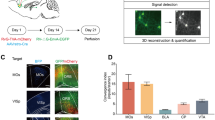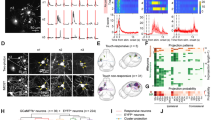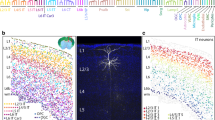Abstract
The activity of cells in the magnocellular red nucleus (RNm) was recorded extra and intracellularly in the curarized thalamic cat performing fictive locomotion. The locomoter episodes were detected from the rhythmic activity recorded in the motor nerves of the contralateral hindlimb. It was confirmed that, during fictive locomotion, a large proportion of the rubrospinal cells (56% in our sample) exhibit a rhythmic pattern of activity which is synchronized with the efferent spinal motor nerve activity. On the basis of the intracellular recordings it was established that phases of intense synaptic activity with mixed excitatory postsynaptic potentials (EPSPs) and inhibitory postsynaptic potentials (IPSPs) are involved in this rhythmicity. After eliminating the cerebellar input to the RNm, it was observed that the cells still received intense excitatory and inhibitory inputs, resulting in a continuous modulation of their membrane potential, due to the occurrence of EPSPs and IPSPs. During fictive locomotor like activity and after elimination of the cerebellar afferents to the RNm, it was observed that the spontaneous PSPs in RNm cells (in the case of 45% of the cells) were organized in repetitive subthreshold bursts occurring in phase relationships with the activity recorded in the motor nerves. Some extracellularly recorded cells (12%) showed a rhythmic firing pattern. It is generally recognized that, in the thalamic cat preparation, the locomotor pattern observed in efferent nerves originates from the central pattern generator (CPG) of the spinal cord. It therefore seems likely that the rhythmicity observed here in the RNm may originate from the spinal CPG and be transmitted through the spino rubral pathway ascending in the ventral part of the cord. It is concluded that the spino rubral pathway may transmit both somatosensory information and corollary discharges relating to the activity of the spinal CPG for locomotion.
Similar content being viewed by others
References
Armstrong DM, Edgley SA (1984) Discharges of nucleus inter positus neurones during locomotion in the cat. J Physiol (Lond) 351:411–432
Arshavsky YI, Orlovsky GN, Pavlova GA, Perret C (1978) Messages conveyed by descending tracts during scratching in the cat. II. Activity of rubrospinal neurons. Brain Res 159:111–123
Arshavsky YI, Orlovsky GN, Perret C (1988) Activity of rubrospinal neurons during locomotion and scratching in the cat. Behav Brain Res 28:193–200
Baldissera F, Hultborn H, Illert M (1981) Integration in spinal neuronal systems. In: Brooks VB (eds) Motor control. (Handbook of physiology, sect 1, The nervous system, vol II) American Physiological Society, Bethesda, MD, pp 509–595
Brock LG, Coombs JS, Eccles JC (1953) Intracellular recording from antidromically activated motoneurones. J Physiol (Lond) 122:429–461
Cabelguen JM, Millanvoye M, Perret C (1973) Caractéristiques centrales et efférentes de l'activité rythmique de type locomoteur chez le chat décortiqué aigu après ablation du cervelet (abstract). J Physiol (Paris) 67:253A
Daadi M, Condé F, Gavioli M, Padel Y (1991) Existence of collateral branching to the red nucleus from the spinothalamic system in the cat. Demonstration using a double labelling neuroanatomical method. Eur J Neurosci [Suppl] 4:34
Davis R (1969) Brachiorubral and rubrobrachial activity in the cat. Brain Res 15:157–173
Dubuc R, Cabelguen JM, Rossignol S (1988) Rhythmic fluctuations of dorsal root potentials and antidromic discharges of primary afferents during fictive locomotion in the cat. J Neurophysiol 60:2014–2036
Eccles RM, Lundberg A (1958) Integrative pattern of Ia synaptic actions on motoneurones of hip and knee muscles. J Physiol (Lond) 144:271–298
Eccles RM, Lundberg A (1959) Synaptic actions in motoneurones by afferents which may evoke the flexion reflex. Arch Ital Biol 97:199–221
Edgerton VR, Grillner S, Sjöström A, Zangger P (1976) Central generation of locomotion in vertebrates. In: Herman R, Grillner S, Stein P, Stuart D (eds) Neural control of locomotion, vol 18. Plenum, New York, pp 439–464
Engberg I, Lundberg A (1969) An electromyographic analysis of muscular activity in the hindlimb of the cat during unrestrained locomotion. Acta Physiol Scand 75:614–630
Grillner S (1969) The influence of DOPA on the static and the dynamic fusimotor activity to the triceps surae of the spinal cat. Acta Physiol Scand 27:490–509
Grillner S (1981) Control of locomotion in biped, tetrapods and fish. In: Brooks VB (eds) Motor control. (Handbook of physiology, Sect 1, The nervous system, vol II) American Physiological Society, Bethesda, MD, pp 1179–1236
Grillner S (1986) The effect of lDOPA on the spinal cord. Relation to locomotion and the half center hypothesis. In: Grillner S, Stein PSG, Stuart DG, Forssberg H, Herman RM (eds) Neurobiology of vertebrate locomotion. (International symposium series, vol 45) Wenner-Gren, Stockton, NY, pp 269–277
Grillner S, Zangger P (1974) Locomotor movements generated by the deafferented spinal cord. Acta Physiol Scand 91:38A-39A
Holmqvist B, Lundberg A, Oscarsson O (1960) Supraspinal inhibitory control of transmission to three ascending spinal pathways influenced by the flexion reflex afferents. Arch Ital Biol 98:60–80
Jankowska E, Jukes MGM, Lund S, Lundberg A (1967a) The effect of DOPA on the spinal cord. 5. Reciprocal organization of pahtways transmitting excitatory action to alpha motoneurones of flexors and extensors. Acta Physiol Scand 70:369–388
Jankowska E, Jukes MGM, Lund S, Lundberg A (1967b) The effect of DOPA on the spinal cord. 6. Half centre organization of interneurones transmitting effects from the flexor reflex afferents. Acta Physiol Scand 70:389–402
fnLundberg A (1959) Integrative significance of patterns of connections made by muscle afferents in the spinal cord. In: Congress International de Ciencias Fisiologicas XXI, Buenos Aires, pp 100–105
Lundberg A (1969) Reflex control of stepping. In: The Nansen Memorial Lecture V, Universitetsforlaget Oslo, pp 5–42
Lundberg A (1982) Inhibitory control from the brain stem of transmission from primary afferents to motoneurones, primary afferent terminals and ascending pathways. In: Sjölund B, Börklund A (eds) Brain stem control of spinal mechanism. Elsevier Biomedical, Amsterdam, pp 179–224
Lundberg A, Oscarsson O (1962) Two ascending spinal pathways in the ventral part of the cord. Acta Physiol Scand 54:270–286
Murakami F, Katsumaru H, Wu JY, Matsuda T, Tsukahara N (1983) Immunocytochemical demonstration of GABAergic synapses on identified rubrospinal neurons. Brain Res 267:357–360
Orlovsky GN (1972a) Activity of rubrospinal neurons during locomotion. Brain Res 46:99–112
Orlovsky GN (1972b) Work of the neurons of the cerebellar nuclei during locomotion. Biophysics 17:1177–1185
Orlovsky GN, Feldman AG (1972) Role of afferent activity in the generation of stepping movements. Neurophysiology 4:304–310
Orsal D, Perret C, Cabelguen JM (1988) Comparison between ventral spinocerebellar and rubrospinal activities during locomotion in the cat. Behav Brain Res 28:159–162
Oscarsson O (1973) Functional organization of spinocerebellar paths. In: Iggo A (eds) Somatosensory system. (Handbook of sensory physiology, vol II) Springer, Berlin Heidelberg New York, pp 339–380
Padel Y, Armand J, Smith AM (1972) Topography of rubrospinal units in the cat. Exp Brain Res 14:363–371
Padel Y, Bourbonnais D (1985) A ventral spinal pathway transmitting sensory input to rubrospinal cells in the cat. Neurosci Lett [Suppl 22] S8
Padel Y, Jeneskog T (1981) Inhibition of rubrospinal cells by somaesthetic afferent activity. Neurosci Lett 21:177–182
Padel Y, Relova JL (1988) A common somaesthetic pathway to red nucleus and motor cortex. Behav Brain Res 28:153–157
Padel Y, Relova JL (1991) Somatosensory responses in the cat motor cortex. I. Identification and course of an afferent pathway. J Neurophysiol 66:2041–2058
Padel Y, Sybirska E (1984) Where is the synaptic relay in the sensory pathway to red nucleus? Neurosci Lett [Suppl 18] S391
Padel Y, Bourbonnais D, Sybirska E (1986) A new pathway from primary afferents to the red nucleus. Neurosci Lett 64:75–80
Padel Y, Sybirska E, Bourbonnais D, Vinay L (1988) Electrophysiological identification of a somaesthetic pathway to the red nucleus. Behav Brain Res 28, 139–151
Perret C (1968) Relations entre activités efférentes spontanées de nerfs moteurs de la patte postérieure et activités de neurones du tronc cérébral chez le chat décortiqué. J Physiol (Paris) 60:511–512
Perret C (1976) Neural control of locomotion in the decorticate cat. In: Herman RM, Grillner S, Stein PSG, Stuart DG (eds) Neural control of locomotion. Plenum, New York, pp 587–615
Perret C, Cabelguen JM (1980) Main characteristics of the hindlimb locomotor cycle in the decorticate cat with special reference to bifunctional muscles. Brain Res 187:333–352
Perret C, Millanvoye M, Cabelguen JM (1972) Messages spinaux ascendants pendant une locomotion fictive chez le chat curarisé (abstract). J Physiol (Paris) 65:153A
Ralston DD, Milroy AM (1989) Red nucleus of Macaca fascicularis: an electron microscopic study of its synaptic organization. J Comp Neurol 284:602–620
Shimamura M, Kogure I, Fuwa T (1984a) Role of joint afferents in relation to the initiation of forelimb stepping in thalamic cats. Brain Res 297:225–234
Shimamura M, Kogure I, Fuwa T (1984b) The role of paralemniscal pontine reticular formation in forelimb stepping of thalamic cats. Neurosci Res 1:393–410
Steeves JD, Jordan LM (1980) Localization of a descending pathway in the spinal cord which is necessary for control treadmill locomotion. Neurosci Lett 20:283–288
Toyama K, Tsukahara N, Udo M (1968) Nature of the cerebellar influences upon the red nucleus neurones. Exp Brain Res 4:292–309
Toyama K, Tsukahara N, Kosaka K, Matsunami K (1970) Synaptic excitation of red nucleus neurones by fibers from interpositus nucleus. Exp Brain Res 11:187–198
Tsukahara N, Toyama K, Kosaka K, Udo M (1965) “Disfacilitation” of red nucleus neurones. Experientia 21:544–1965
Tsukahara N, Toyama K, Kosaka K (1967) Electrical activity of red nucleus neurones investigated with intracellular microelectrodes. Exp Brain Res 4:18–33
Viala D, Valin A, Buser P (1974) Relationship between the “late reflex discharge” and locomotor movements in acute spinal cats and rabbits treated with DOPA. Arch Ital Biol 112:299–306
Vinay L, Padel Y (1990) Spatiotemporal organization of the somaesthetic projections in the red nucleus transmitted through the spinorubral pathway in the cat. Exp Brain Res 79:412–426
Walberg F, Nordby T (1981) A reexamination of the rubroolivary tract in the cat, using horseradish peroxidase as a retrograde and an anterograde neuronal tracer. Neuroscience 6:2379–2391
Walberg F, Dietrichs E, Nordby T (1986) The origin and termination of the dentatorubral fibres in the cat as studied with retro grade and anterograde transport of peroxidase labelled lectin. Exp Brain Res 63:294–300
Author information
Authors and Affiliations
Rights and permissions
About this article
Cite this article
Vinay, L., Padel, Y., Bourbonnais, D. et al. An ascending spinal pathway transmitting a central rhythmic pattern to the magnocellular red nucleus in the cat. Exp Brain Res 97, 61–70 (1993). https://doi.org/10.1007/BF00228817
Received:
Accepted:
Issue Date:
DOI: https://doi.org/10.1007/BF00228817




